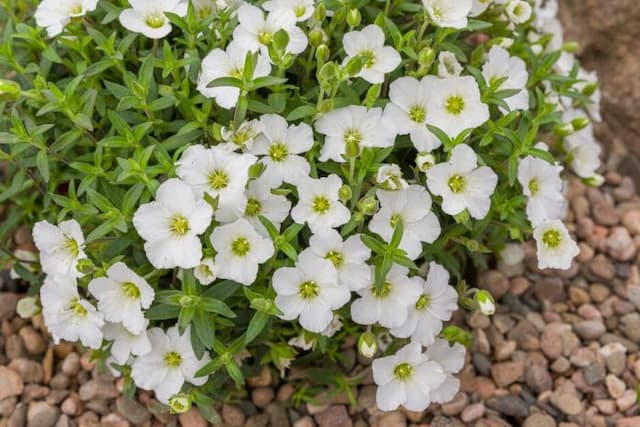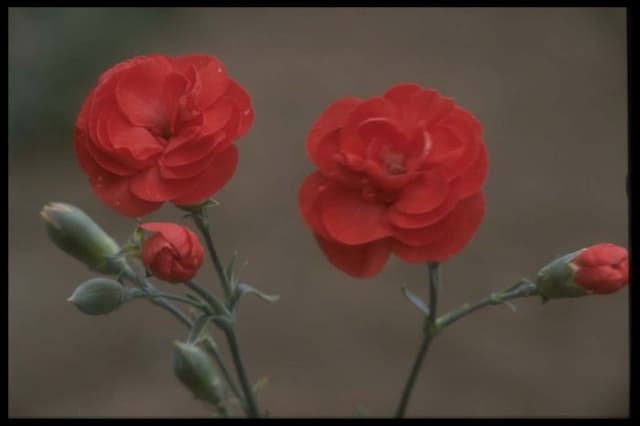Pink Dianthus 'Devon Louise' (PBR) (p)

ABOUT
Dianthus 'Devon Louise' (PBR) (p), commonly known as pinks, is a charming perennial plant that exhibits a compact and bushy habit. Its foliage is typically slender, with grass-like gray-green leaves that form an attractive, dense mound. The plant is well-loved for its profusion of flowers that bloom atop slender, sturdy stems, rising just above the greenery. These flowers are renowned for their delightful fragrance and striking appearance. The blossoms of Dianthus 'Devon Louise' are distinctive, with each flower sporting a frilled or serrated edge, which adds a touch of intricate elegance. The petals themselves are usually a soft pink or blush color, often featuring a subtle gradient of hues that can range from deeper pink at the edges to lighter tones near the center. At the base of each petal, you may notice a darker eye or contrasting coloration, which adds depth and interest to the overall display. The blooms are arranged in loose clusters, creating a generous show of color when the plant is in peak bloom. This variety of Dianthus is especially popular for its long flowering season, providing bursts of color throughout the growing period. Each individual flower consists of five petals that open widely to form a classic, almost round shape when viewed from above. In summary, Dianthus 'Devon Louise' showcases soft pink, sweetly scented flowers with elegantly fringed petals against a backdrop of slender gray-green foliage, bringing a touch of romantic cottage garden charm to any setting where it's planted.
About this plant
 Names
NamesFamily
Caryophyllaceae
Synonyms
Devon Louise Pink, Pink Devon Louise
Common names
Dianthus 'Devon Louise' (PBR) (p)
 Toxicity
ToxicityTo humans
The plant commonly known as Pink is not known to be toxic to humans. Generally, pinks are considered non-toxic, and there are no well-documented cases of poisoning from ingestion of this plant by humans. Therefore, accidental ingestion of Dianthus 'Devon Louise' is unlikely to lead to poisoning or to cause significant symptoms.
To pets
Pinks are not commonly known to be toxic to pets like dogs and cats. There is no significant evidence to suggest that Dianthus 'Devon Louise' would cause poisoning in pets if ingested. As with any non-food plant material, ingestion might cause mild gastrointestinal upset depending on the pet's size, the amount eaten, and the sensitivity of the pet, but serious toxicity is not expected.
 Characteristics
CharacteristicsLife cycle
Perennials
Foliage type
Evergreen
Color of leaves
Blue-green
Flower color
Pink
Height
1 foot [30 cm]
Spread
1 foot [30 cm]
Plant type
Herb
Hardiness zones
5
Native area
Europe
Benefits
 General Benefits
General Benefits- Attractive Blooms: Dianthus 'Devon Louise' produces vivid pink flowers with a distinctive pattern, enhancing garden aesthetics.
- Long Flowering Season: This variety typically has a prolonged flowering period from late spring to early autumn, offering lasting garden interest.
- Fragrant: The flowers emit a pleasant scent, adding a layer of sensory enjoyment to garden spaces.
- Easy to Care For: It is known for being low-maintenance and easy to grow, requiring minimal attention once established.
- Drought Tolerance: Once established, Dianthus 'Devon Louise' is relatively drought-tolerant, making it suitable for gardens with low water availability.
- Compact Growth: With its compact and mounded growth habit, it is an excellent choice for borders, containers, and small garden spaces.
- Attracts Pollinators: The flowers attract butterflies and other beneficial pollinators, promoting biodiversity in the garden.
 Medical Properties
Medical PropertiesThis plant is not used for medical purposes.
 Air-purifying Qualities
Air-purifying QualitiesThis plant is not specifically known for air purifying qualities.
 Other Uses
Other Uses- Dianthus 'Devon Louise' can be used for natural dyeing due to its pigments, typically resulting in light pink or reddish hues when used on fabrics.
- The petals of the Dianthus, also known as pinks, can be crystallized and used as edible decorations for cakes and desserts, adding a subtle clove-like flavor and floral touch.
- Cut Dianthus flowers can be incorporated into homemade potpourris to provide a pleasant fragrance to your home when dried with other aromatic botanicals.
- Pinks can be pressed and included in decorative paper making, adding a unique floral element to handmade stationery or cards.
- The flowers can be used as a natural air freshener when placed in small bowls throughout the home, providing a light natural scent.
- Pinks can be included in bath sachets, where their petals release a subtle fragrance and skin-softening properties into the bathwater.
- When hosting events or dinners, Dianthus petals can be scattered over tables for a colorful and fragrant decorative element.
- Dianthus can be used as a garnish for salads and cocktails, offering a pop of color and a hint of spice to culinary presentations.
- These flowers can be used to create natural confetti for use in celebrations, which is biodegradable and eco-friendly.
- Dianthus flowers can be frozen in ice cubes to make an attractive and unusual accent in iced beverages, adding beauty to summertime drinks.
Interesting Facts
 Feng Shui
Feng ShuiThe Pink is not used in Feng Shui practice.
 Zodiac Sign Compitability
Zodiac Sign CompitabilityThe Pink is not used in astrology practice.
 Plant Symbolism
Plant Symbolism- Love: Dianthus flowers are commonly associated with love due to their vibrant colors and long-lasting blooms.
- Admiration: Gifting a bouquet of these flowers can symbolize deep admiration and recognition of the recipient's uniqueness and individuality.
- Boldness: The bright and striking appearance of Dianthus 'Devon Louise' signifies boldness and the courage to stand out.
- Pure Affection: The delicate and intricate petals of the Dianthus are often related to pure and genuine affection, representing platonic love, friendship, or familial bonds.
- Femininity and Grace: The Dianthus 'Devon Louise' embodies femininity and grace, making it a popular choice for celebrations of womanhood and mothers.
 Water
WaterPink Dianthus, commonly known as 'Devon Louise,' should be watered deeply whenever the top inch of soil feels dry to the touch. In general, this might mean watering once every week, but frequency can vary depending on weather conditions and soil type. Aim to provide the plants with approximately 1 gallon of water per square foot every time you water, ensuring that the moisture reaches the roots without leaving the soil waterlogged. During hot, dry spells, you may need to water more frequently, whereas in cooler, wetter periods, less watering is required. It’s important to avoid overhead watering to prevent foliage diseases; so water at the base of the plant instead.
 Light
LightPink Dianthus thrives best in full sun, so it should receive at least 6 hours of direct sunlight daily. The ideal spot for growing 'Devon Louise' in your garden would be an area that gets unfiltered sunlight for most of the day. If grown indoors, a south-facing window is typically the best location to meet the plant’s light requirements.
 Temperature
TemperaturePink Dianthus is quite temperature tolerant and can survive a range of conditions. These plants prefer cooler climates and do best when daytime temperatures are between 60 and 70 degrees Fahrenheit, but they can tolerate temperatures down to freezing and up to 85 degrees Fahrenheit. Prolonged exposure to temperatures outside this range, especially high heat, can impair their growth and flowering.
 Pruning
PruningPink Dianthus should be pruned to encourage bushier growth and more blooms. Deadheading, or removing spent flowers, should be done regularly to promote continuous blooming throughout the season. After the first flush of flowers has finished, cut back the stems by one-third to encourage a second bloom. Pruning is best done in late winter or early spring before new growth begins.
 Cleaning
CleaningAs needed
 Soil
SoilThe best soil mix for the Pink plant (Dianthus 'Devon Louise') is a well-draining, loamy soil with added organic matter like compost. The ideal soil pH for Dianthus is slightly alkaline, ranging from 7.0 to 7.5. A blend of two parts garden soil, one part sand or perlite, and one part compost or aged manure will provide the drainage and nutrients that Pinks need.
 Repotting
RepottingPinks (Dianthus 'Devon Louise') typically do not need frequent repotting and can often stay in the same pot for several years. However, if you notice the plant becoming root-bound or the soil degrading, repot it in the spring every 2-3 years using the recommended soil mix.
 Humidity & Misting
Humidity & MistingPinks (Dianthus 'Devon Louise') prefer moderate humidity levels and do not require high humidity. These plants do well in the average humidity found in most homes and gardens, without the need for additional humidity measures.
 Suitable locations
Suitable locationsIndoor
Ensure sunny spot, well-draining soil, and water when dry.
Outdoor
Place in full sun, well-drained area, water sparingly.
Hardiness zone
4-9 USDA
 Life cycle
Life cycleDianthus 'Devon Louise', commonly known as Pink 'Devon Louise', begins its life cycle as a seed, which, when sown, germinates to produce small seedlings. These seedlings then develop a root system and foliage as they grow into vegetative plants. Over time, the plants reach maturity and produce distinctive flowers, characterized by their frilled edges and sweet fragrance, typically blooming in late spring to early summer. After pollination, which can be aided by insects like bees and butterflies, seeds are produced within the spent flower for propagation if conditions permit. Throughout summer and into autumn, these perennials may continue to bloom intermittently. Finally, as temperatures drop in late autumn, the plant enters a dormant state to conserve energy for the ensuing growing season, though depending on the climate, it may remain evergreen.
 Propogation
PropogationPropogation time
Spring-Early Summer
Propogation: Dianthus 'Devon Louise', commonly known as Pink, is typically propagated by cuttings to ensure the new plants retain the characteristics of the parent. The best time to take cuttings is in late spring or early summer when the plant's growth is most vigorous. To propagate by cuttings, a gardener would select a healthy, non-flowering stem and cut a section 4 to 6 inches long just below a node. This cutting should then be stripped of its lower leaves, and the cut end may be dipped in rooting hormone to encourage root growth. The cutting is then inserted into a moist, well-draining soil mix, ensuring at least one node is below the surface. A plastic cover or dome can be placed over the cutting to maintain humidity, and it should be kept in a warm, bright location out of direct sunlight. With proper care, roots will typically develop in a few weeks, at which point the cutting can be transplanted.


![Pink [Tequila Sunrise]](/_next/image?url=https%3A%2F%2Fplants-admin.emdemapps.com%2Fimages%2Fplants%2F%2Fimages%2F604b5d995d06e.png&w=640&q=75)






